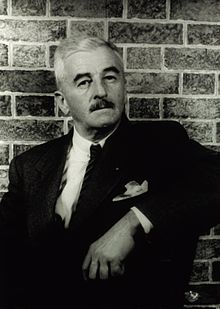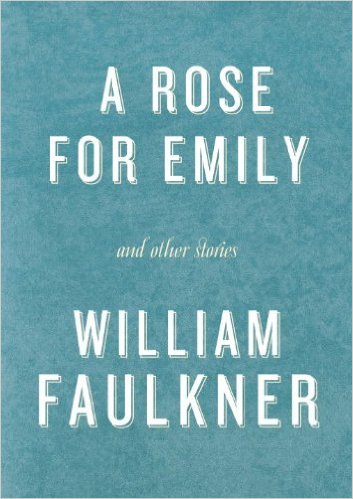
photo © Brent Moore, 2011
by Sharon Telfer
How many words does it take to build a world?
I’d never really thought about this before a brief exchange with a friend. I was writing flash fiction, I said, and loving it. Not the form for her, she replied. She favoured the epic, because it meant ‘building a whole world’. And that’s about as far as it went. Well, it was Twitter. But her conviction that short stories couldn’t conjure a world stayed with me.
Then, one spare half-hour between stopping work and starting supper, a story picked at random from an old anthology settled the question for me. At around 4,500 words, no one could call it epic. But there it was, a world complete in itself, at once believable yet unsettlingly strange, resonating long after the book is closed.
That story was ‘Dry September’ by William Faulkner. Published in 1931, it tells of a black man lynched for some rumoured and unspecified assault on a white woman one hot night in the American South.
We are in the small world of small-town America. From a barbershop, where a lynch mob forms, the action moves on to the semi-industrial outskirts. Here, an accused man, Will Mayes, is abducted and murdered. The last sections return to the heart of town, to the impact on the townsfolk, on Minnie Cooper – who is both subject and initiator of the rumour that spurs the lynch mob – and, finally, on McLendon, leader of the mob. Time runs from ‘bloody’ twilight to midnight, bar eight short paragraphs that sum up Minnie’s earlier life.
As such tight setting suggests, Faulkner has created a claustrophobic world. Its threads are closely spun, binding lives together, placing them under tension.
 Minnie and her ‘avenger’, McLendon, never meet. But they – and the barber who is the conscience of the story – are entwined by the word ‘furious’. Whipping up the mob, McLendon’s face is ‘furious, rigid’, while Minnie’s life has ‘a quality of furious unreality’ and she wears ‘that bafflement of furious repudiation of truth in her eyes’. The barber, entangled with the mob as he tries in vain to defuse it, begins ‘to tug furiously at the [car] door’, jumping out as it drives away with the victim. By the final paragraph, not even murder has dissipated McLendon’s fury. Back home, he ‘hunts furiously’ for the shirt he has just removed to wipe the sweat from his body. After sixty-two rainless days, this is a world with no relief, where fury can never be spent.
Minnie and her ‘avenger’, McLendon, never meet. But they – and the barber who is the conscience of the story – are entwined by the word ‘furious’. Whipping up the mob, McLendon’s face is ‘furious, rigid’, while Minnie’s life has ‘a quality of furious unreality’ and she wears ‘that bafflement of furious repudiation of truth in her eyes’. The barber, entangled with the mob as he tries in vain to defuse it, begins ‘to tug furiously at the [car] door’, jumping out as it drives away with the victim. By the final paragraph, not even murder has dissipated McLendon’s fury. Back home, he ‘hunts furiously’ for the shirt he has just removed to wipe the sweat from his body. After sixty-two rainless days, this is a world with no relief, where fury can never be spent.
Significant words appear then reappear like this, often in oppressive proximity. Minnie Cooper is introduced as having a ‘bright, faintly haggard manner and dress’. And, when braving the public after the lynching, still ‘her eyes are bright in the haggard banner of her face’. Such a verbal palette paints a background wash of restriction, stasis, inevitability.
An eerie metallic sheen glimmers over everything in this story. Two significant objects – McLendon’s pistol and the barber’s razor, both potentially lethal – give this solid form. But the air itself leaves ‘a metallic taste at the base of the tongue’, evoking the taste of blood, and the darkening sky is ‘as clear as the inside of a brass bell’. Just before they strike, the mob ‘seemed to breathe, to live, in a bowl of molten lead’. Later Minnie tries to escape emotionally to the ‘silver dream’ of the moving pictures.
Yet within this metallic atmosphere beats a strong animal physicality. The stick and stench of sweat are pervasive, and breath hangs heavy, suffusing all the senses. Those in the barbershop are caught in the endless circulation of ‘their own stale breath’, stirred by the ineffectual fan. Unhappy Minnie bears the telltale smell of whisky on her breath daily. Will is taken in ‘the breathless dark’. The lynch mob can feel Will’s breath on their faces; before they strike, they expel their own ‘in a dry hissing’.
Violence, too, permeates both the language and the action from the start. Even the peace-seeking barber cannot escape it. Arguing for reason, he at first tries to carry on working. But Faulkner’s description is ominous: ‘The barber held [the client’s] face down, the razor poised’. A disturbing undercurrent of sexual assault implicates him more deeply: ‘The barber had been slowly forcing him back into the chair; he arrested himself reclining, his head lifted, the barber still pressing him down’. We feel already how futile the barber’s resistance will be.
This world seems almost to hinge on such tensions. McLendon, so quick to defend the unspecified ‘honour’ of an unknown white woman, abuses his wife at home. Only ice calms Minnie’s hysteria – ice presumably from the factory where Will Mayes works. Arguing over what to do, the men in the barbershop constantly set ‘white’ against ‘black’ in racist opposition. But, confronting each other, it is two white men, McLendon and the barber, who ‘looked like men of different races’.
A disorientating mix of rush and stillness in the prose reinforces this. Doors crash open, men spring up, cars hurl along. Minnie glitters, crisps and crackles. The men erupt in physical violence, Minnie in hysterical laughter. But the murder itself happens off-stage. Speech frequently breaks off, incomplete, or dissolves into question and uncertainty. The language forces clashing concepts together. The car’s speed is ‘like an extinct furnace blast: cooler, but utterly dead’. Streetlights glare in ‘rigid and violent suspension in the lifeless air’. Finally, McLendon stands sweating and panting while around him, ‘There was no movement, no sound, not even an insect’.
Above all, this is a world built itself from story. The form alludes to several types of narrative – carefully paced across five parts, it mimics the five acts of classic drama, and the new wave of gangster films in the late 1920s clearly influences the writing. With his beard of shaving foam, a barber’s customer looks ‘like a desert rat in the moving pictures’; when setting off, the mob’s ‘car slid squealing out of a cloud of dust…’; arriving  at the ice factory where Will Mayes works, it ‘slammed to a stop, the headlights glaring on the blank wall’. The dialogue echoes gangster films too. “He went on a little trip,” says someone, when asked what has happened to Will. It’s as if the townsfolk themselves are trying to rewrite their world to a different script – escaping the perpetual dust that hangs over their dry land through stories.
at the ice factory where Will Mayes works, it ‘slammed to a stop, the headlights glaring on the blank wall’. The dialogue echoes gangster films too. “He went on a little trip,” says someone, when asked what has happened to Will. It’s as if the townsfolk themselves are trying to rewrite their world to a different script – escaping the perpetual dust that hangs over their dry land through stories.
The tragedy here is that those stories remain unclear, inaccurate and incomplete. The tale begins with the spreading of the ‘rumor, the story, whatever it was’. What is Will Mayes supposed to have done? Nobody knows for sure. Nor do we, the readers, ever find out. The opening paragraph should feel clear. ‘None of them … knew exactly what had happened.’ But it stalls. My ellipsis marks a gap: in full, no less than six sub-clauses separate (and cloud) the two parts of that apparently straightforward statement.
How old is Minnie? “About forty, I reckon,” says the barber. But even the narrator isn’t certain: ‘She was thirty-eight or thirty-nine.’ Her social status turns on rumour, reputation and eavesdropping. When she was younger, ‘One evening at a party she heard a boy and two girls, all schoolmates, talking. She never accepted another invitation’. We do not know what was said. Already past her prime at twenty-six, stepping out with a widower tarnishes her reputation and the town both resents and recasts her:
He owned the first automobile in town, a red runabout; Minnie had the first motoring bonnet and veil the town ever saw. Then the town began to say: ‘Poor Minnie.’
Minnie’s social life dwindles until the only time she goes out at night is to the ‘miniature fairyland’ of the picture house. For Minnie, movies are not stories but life: ‘The screen glowed silver, and soon life began to unfold, beautiful and passionate and sad.’ But her attempt to control and rewrite her own story through her vague accusation collapses. She is forced to face up to the relentless fantasy of the cinema: ‘the silver dream accumulated, inevitably on and on.’ She breaks down, all articulacy gone. ‘But soon the laughing welled again and her voice rose screaming.’ Her friends can respond only: “Shhhhhhhhhh! Shhhhhhhhhhhhh!”
Even the intimidating McLendon threatens the barber through the spoken word rather than physical violence: “By God, tomorrow when this town hears about how you talked tonight…” But he too undermines his own stories. When someone questions the reliability of Minnie’s account, McLendon tangles his ‘truth’ in rhetorical knots: “Happen? What the hell difference does it make? Are you going to let the black sons get away with it until one really does it?”
And, at the heart of the tale, are those who are denied the right to story altogether. Will Mayes, so talked about and categorised by others, has around five brief lines of speech of his own. We know nothing about him, beyond his race, his job and the barber’s testimony: “I know Willy Mayes. It wasn’t him.”
We do not see him killed, only the cars returning without him. What has happened to him is never explicitly stated. But we know what is going to happen to Will from the start. We can complete the story ourselves. And so we become complicit. Like the barber, all we can do is bail out, as the narrative takes the murder elsewhere. With Will’s death, all the black residents seem simply to disappear. Walking her to the pictures, Minnie’s friends point out: “There’s not a Negro on the square. Not one.”
This is a hard tale to read. The racism it explores is repellent, but as much in need of exposing today. Some stylistic aspects, however, feel troubling for a contemporary reader. The point of view is very much that of a white male. I bridle at the portrayal of the spinster – ‘old’ at not yet forty – whose single status clearly marks her as sexually frustrated and therefore untrustworthy and a fantasist. I wonder how black readers – then or now – feel about the way helpless, passive Will Mayes is written.
So why do I recommend it? In ten short pages, Faulkner constructs a world that utterly convinces on its own terms. He builds it from characters that act as paradigms but still feel like individuals, from both realistic patterns of speech and startling metaphor, from telling concrete details overlaid with a universal and metaphysical strangeness.
That’s why I love short stories. The greatest plunge you into a different world like an icy pool, leaving you gasping yet invigorated. Epic, with its long accumulations, can undoubtedly be a pleasure, but it tends to take you out of the world you live in, not reengage you with it. Too often, it feels like a discovery trail: all you need do is encounter what the writer has left for you to find. The very restrictions of the short story form mean not just that the writer must make every word count, but that you must read between the lines, co-creating much of the world yourself.
The paradox is that ‘Dry September’ demonstrates the danger of hanging our worlds on story. It is a masterclass in just how few words a writer needs to build a world. But it is also a chilling warning about just how few words it takes to destroy one.
~
 Sharon Telfer is a freelance writer and editor who spends her writing life keeping things short. She has been translating complex research into clear, concise prose for over twenty years. This has been surprisingly helpful in discovering how stories work. She won the Thresholds Feature Writing Competition in 2014 and some small, but encouraging, flash fiction prizes in 2015. She shares writing tips on Twitter as @sharontelfer.
Sharon Telfer is a freelance writer and editor who spends her writing life keeping things short. She has been translating complex research into clear, concise prose for over twenty years. This has been surprisingly helpful in discovering how stories work. She won the Thresholds Feature Writing Competition in 2014 and some small, but encouraging, flash fiction prizes in 2015. She shares writing tips on Twitter as @sharontelfer.

